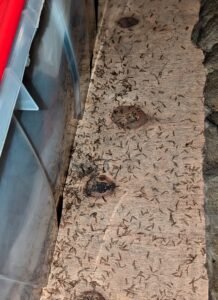There are Three Options When You Have Termites:
The third option is always the most expensive.
When facing a termite infestation in your home, you essentially have three options:
- Tent fumigation
- Local treatment of infested areas
- Do nothing
Surprisingly, many people choose the third option.
In numerous homes we’ve inspected, owners discovered termite activity and either tried DIY solutions or ignored the problem, hoping it would go away. Some even taped over a drywood termite kick-out hole, assuming the issue was resolved when the droppings stopped accumulating.
inspected, owners discovered termite activity and either tried DIY solutions or ignored the problem, hoping it would go away. Some even taped over a drywood termite kick-out hole, assuming the issue was resolved when the droppings stopped accumulating.
However, drywood termites don’t disappear that easily. They live inside the wood and often chew through drywall to clear out their droppings to make more space for their expanding colony. If droppings stop in one area, it’s likely because the termites found a new spot to kick them out.
The photo to the right was taken in a customer’s attic that we inspected one year ago. At that time, we proposed a local and borate treatment. Unfortunately, this customer decided to do nothing. When we re-inspected their attic we found this pile of termite wings. That means there was a termite swarm inside their attic. If the attic wood had been treated with borates, the swarming termites would have died when they bit into the treated wood. But, because there was no treatment and we found this and four other areas of infestation, this person will need to tent their home.
Why Over-the-Counter Products Don’t Work
Store-bought termite treatments typically only kill on contact. Termites can detect these substances and will simply avoid them, burrowing deeper into your home’s wood. Even if you manage to kill some worker termites (the ones that chew the wood), it’s like killing a trail of ants—unless you eliminate the queen, she’ll just produce more workers.
The Cost of Doing Nothing
Ignoring a termite problem won’t make it go away; it will only get worse. If you catch an infestation early, a professional local treatment might be enough to solve the problem. Local treatments are generally more affordable than tent fumigations and far more convenient for homeowners.
However, if you wait, it’s not just the cost of treatment that will increase—the biggest expense could be wood repairs. Drywood termites can chew through a rafter tail in under a year and can cause extensive damage to fascia boards and other structural elements over time. If the damaged wood
is on the second floor or connected to gutters, the repair costs can be significantly higher. In fact, wood repair costs can easily double or triple the expense of treating the infestation.
If you notice any signs of termite activity, contact a professional termite company immediately. Termite inspections are usually free, so there’s no reason to delay. And if an inspector only finds one spot of activity, don’t think, “It’s not that bad. Let’s wait and see.” What you’re seeing is likely two years in the making, and there’s more damage you can’t see.
Owning a home in California often means you’re sitting on a substantial investment. Protect your biggest asset by addressing small problems before they grow into bigger, more expensive ones.
